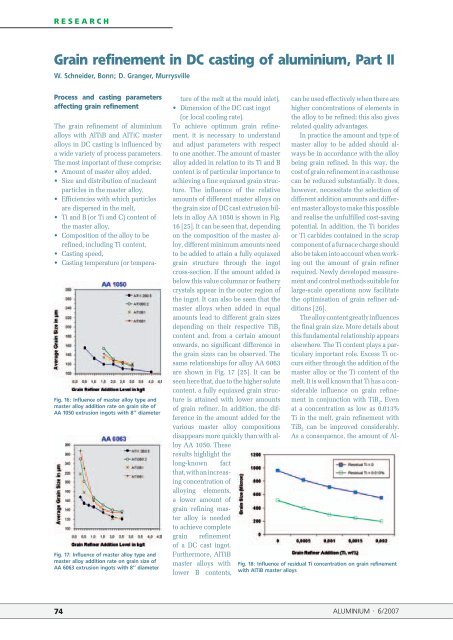Sie wollen auch ein ePaper? Erhöhen Sie die Reichweite Ihrer Titel.
YUMPU macht aus Druck-PDFs automatisch weboptimierte ePaper, die Google liebt.
RESEARCH<br />
Grain refinement in DC casting of aluminium, Part II<br />
W. Schnei<strong>de</strong>r, Bonn; D. Granger, Murrysville<br />
Process and casting parameters<br />
affecting grain refinement<br />
The grain refinement of aluminium<br />
alloys with AlTiB and AlTiC master<br />
alloys in DC casting is influenced by<br />
a wi<strong>de</strong> variety of process parameters.<br />
The most important of these comprise:<br />
• Amount of master alloy ad<strong>de</strong>d,<br />
• Size and distribution of nucleant<br />
particles in the master alloy,<br />
• Efficiencies with which particles<br />
are dispersed in the melt,<br />
• Ti and B (or Ti and C) content of<br />
the master alloy,<br />
• Composition of the alloy to be<br />
refined, including Ti content,<br />
• Casting speed,<br />
• Casting temperature (or tempera-<br />
Fig. 16: Influence of master alloy type and<br />
master alloy addition rate on grain site of<br />
AA 1050 extrusion ingots with 8‘‘ diameter<br />
Fig. 17: Influence of master alloy type and<br />
master alloy addition rate on grain size of<br />
AA 6063 extrusion ingots with 8‘‘ diameter<br />
ture of the melt at the mould inlet),<br />
• Dimension of the DC cast ingot<br />
(or local cooling rate).<br />
To achieve optimum grain refinement,<br />
it is necessary to un<strong>de</strong>rstand<br />
and adjust parameters with respect<br />
to one another. The amount of master<br />
alloy ad<strong>de</strong>d in relation to its Ti and B<br />
content is of particular importance to<br />
achieving a fine equiaxed grain structure.<br />
The influence of the relative<br />
amounts of different master alloys on<br />
the grain size of DC cast extrusion billets<br />
in alloy AA 1050 is shown in Fig.<br />
16 [25]. It can be seen that, <strong>de</strong>pending<br />
on the composition of the master alloy,<br />
different minimum amounts need<br />
to be ad<strong>de</strong>d to attain a fully equiaxed<br />
grain structure through the ingot<br />
cross-section. If the amount ad<strong>de</strong>d is<br />
below this value columnar or feathery<br />
crystals appear in the outer region of<br />
the ingot. It can also be seen that the<br />
master alloys when ad<strong>de</strong>d in equal<br />
amounts lead to different grain sizes<br />
<strong>de</strong>pending on their respective TiB 2<br />
content and, from a certain amount<br />
onwards, no significant difference in<br />
the grain sizes can be observed. The<br />
same relationships for alloy AA 6063<br />
are shown in Fig. 17 [25]. It can be<br />
seen here that, due to the higher solute<br />
content, a fully equiaxed grain structure<br />
is attained with lower amounts<br />
of grain refiner. In addition, the difference<br />
in the amount ad<strong>de</strong>d for the<br />
various master alloy compositions<br />
disappears more quickly than with alloy<br />
AA 1050. These<br />
results highlight the<br />
long-known fact<br />
that, with an increasing<br />
concentration of<br />
alloying elements,<br />
a lower amount of<br />
grain refining master<br />
alloy is nee<strong>de</strong>d<br />
to achieve complete<br />
grain refinement<br />
of a DC cast ingot.<br />
Furthermore, AlTiB<br />
master alloys with<br />
lower B contents,<br />
can be used effectively when there are<br />
higher concentrations of elements in<br />
the alloy to be refined; this also gives<br />
related quality advantages.<br />
In practice the amount and type of<br />
master alloy to be ad<strong>de</strong>d should always<br />
be in accordance with the alloy<br />
being grain refined. In this way, the<br />
cost of grain refinement in a casthouse<br />
can be reduced substantially. It does,<br />
however, necessitate the selection of<br />
different addition amounts and different<br />
master alloys to make this possible<br />
and realise the unfulfilled cost-saving<br />
potential. In addition, the Ti bori<strong>de</strong>s<br />
or Ti carbi<strong>de</strong>s contained in the scrap<br />
component of a furnace charge should<br />
also be taken into account when working<br />
out the amount of grain refiner<br />
required. Newly <strong>de</strong>veloped measurement<br />
and control methods suitable for<br />
large-scale operations now facilitate<br />
the optimisation of grain refiner additions<br />
[26].<br />
The alloy content greatly influences<br />
the final grain size. More <strong>de</strong>tails about<br />
this fundamental relationship appears<br />
elsewhere. The Ti content plays a particulary<br />
important role. Excess Ti occurs<br />
either through the addition of the<br />
master alloy or the Ti content of the<br />
melt. It is well known that Ti has a consi<strong>de</strong>rable<br />
influence on grain refinement<br />
in conjunction with TiB 2 . Even<br />
at a concentration as low as 0.013%<br />
Ti in the melt, grain refinement with<br />
TiB 2 can be improved consi<strong>de</strong>rably.<br />
As a consequence, the amount of Al-<br />
Fig. 18: Influence of residual Ti concentration on grain refinement<br />
with AlTiB master alloys<br />
74 ALUMINIUM · 6/2007

















